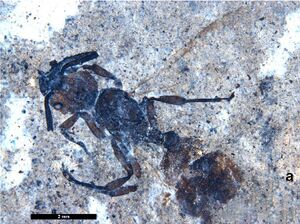Myrmica schaefersi
| †Myrmica schaefersi Temporal range: Oligocene Enspel Formation, Rhineland-Palatinate, Germany | |
|---|---|

| |
| Scientific classification | |
| Kingdom: | Animalia |
| Phylum: | Arthropoda |
| Class: | Insecta |
| Order: | Hymenoptera |
| Family: | Formicidae |
| Subfamily: | Myrmicinae |
| Tribe: | Myrmicini |
| Genus: | Myrmica |
| Species: | †M. schaefersi |
| Binomial name | |
| †Myrmica schaefersi Jessen, 2020 | |
Identification
Jessen (2020) - Differs from ‘’Myrmica nungesseri’’ mainly in its wide head shape with its distinct and rounded occipital corners. Additionally, the mandible seems to be more elongate in ‘’M. schaefersi’’ than in ‘’M. nungesseri’’.
Distribution
This taxon was described from Enspel Formation, Rhineland-Palatinate, Germany (Oligocene).
This species and other fossil ants were collected as part of yearly excavation campaigns between 1995 and 2013 conducted by the Directorate General for Cultural Heritage Rhineland-Palatinate, Directorate Archaeology, Department of Earth History.
Castes
Queen
 
| |
| . | |
Nomenclature
The following information is derived from Barry Bolton's Online Catalogue of the Ants of the World.
- †schaefersi. †Myrmica schaefersi Jessen, 2020: 28, figs, 11a-c (q.) GERMANY.
Unless otherwise noted the text for the remainder of this section is reported from the publication that includes the original description.
Description
Queen
Holotype BLw/ oG: 4.53, HL: 1.56, HW: 1.40, ED: 0.26, GeL: 0.29 (est.), ML: 0.79, MML: 0.34, SL: 1.18, AL: 1.82, ScuL: 0.84, ScutL: 0.47 (incl. prescutellum), FWL: 4.89, HiTL: 1.01, PL: 0.51, PH: 0.40, PPL: 0.29, PPH: 0.54, HeH: 0.28. Wing venation 1Cu: 0.71, 1M: 0.41, m-cu: 0.43, 1RS+M: 0.25. Indices: CI: 89.62, SI: 84.21, IED/HL: 16.98, IHL/AL: 85.75, Imcu: 35.42.
Position: Head, alitrunk, petiole, postpetiole and parts of gaster from dorsolateral, part of forewing and hind wing.
Colour: Medium brown; clypeus, mandibles, antenna, and tarsi dark brown.
BL about 6.95. Head slightly longer than wide. Relatively small eyes are located below head’s mid length. Head is about 8.7 times longer than maximum inner eye diameter. The middle parts of the eyes are missing. Circumocular sulcus strongly sclerotized. Dark brown. Mandibles elongate, not triangular, slightly curved like a flat shovel. Masticatory margin with 5–6 teeth. Apical and sub-apical teeth can only be identified by marks in the sediment. Apical tooth distinctly longer than sub-apical tooth. Other teeth smaller than apical and sub-apical teeth. Antennal sockets widely separated. Anterior clypeus margin smooth, gradually pointed in the middle. Median portion of clypeus with longitudinal wide striae. In addition, a pair of distinct ridges can be identified in the middle of the clypeus and one on both sides starting from the frontal lobe running anteriorly, reaching anterior margin of clypeus. Frontal carinae diverging towards both sides; they clearly project beyond the posterior eyes margin. Frontal triangle is missing or not apparent. Scape reaches posterior margin of head. Scape stout and widely curved at base. Apical and sub-apical funicular segments of antenna partly missing. Antenna is 12-segmented with a 4-segmented club. Funicular segments 6 to 9 wider and shorter than the others. Condylar bulb well preserved, half covered by frontal lobes. Head sculptured with longitudinal, slightly irregular widely spaced striae, posteriorly sculpturing turns more into a reticulate pattern. Alitrunk seems to be fairly high, with flat scutum, prescutellum and scutellum. Scutum does not extend towards anterior and lateral parts of alitrunk. Around the anterior margin, scutum appears arched and stepped. Prescutellum at sides distinctly longer than in the middle. Metanotum strongly sclerotized, dark brown in colour. Propodeum fairly steeply descending. Two propodeal spines widened at base can be identified, slightly diverging posteriorly. Scutum with distinct longitudinal striae. Promesonotal suture is strongly sculptured. Propodeum with longitudinally widely spaced striae. Wing venation poorly preserved. One forewing with closed cell mcu and one hind wing can be identified. Forelegs with well-developed combed tibial spurs. Petiole with a very short, dorsally slightly concave peduncle forms posteriorly into a round node. Postpetiole slightly elongate with gradually ascending anterior face and rounded node. Helcium starts at about halflength of petiole's posterior face. Postpetiole's tergite and sternite do not appear to have grown together firmly. Posterior face of postpetiole short; it is broadly connected with first gastral segment. Gaster not complete, sclerites are weakly sclerotized. At postpetiole-gaster articulation first gastral tergite is thickened. Posterior to this articulation a semicircle structure can be identified. These structures are interpreted as so-called “pillars”, being associated with the stridulation organ.
Type Material
Holotype: NHMM-PE2009/5826-LS, winged gyne. Enspel Oilshale, Rhineland-Palatinate, Germany. Enspel Formation, Upper Oligocene, MP 28; (24.56–24.79 Ma, Mertz et al. 2007), layer S16.
Abbreviation of specimen numbers:NHMM= Naturhistorisches Museum Mainz; PE = Palaeontology Entomology; 2009 = found in 2009; 6281 = running inventory number of the year; LS = Landessammlung (State Collection). Information on the layer is given. They refer to the standard profile in Felder et al. (1998).
Currently stored in the Directorate General for Cultural Heritage Rhineland-Palatinate, Directorate Archaeology, Department Earth History, Mainz, Germany. In the long term, they will be deposited in the “Typothek” of the State Collection of Natural History Rhineland-Palatinate/Museum of Natural History Mainz, Mainz, Germany (NHMM).
Etymology
Honouring Petra Schaefers, Mainz, specialist for the “not preparable”, and who was one of the supervisors of the former scientific excavations in the oilshales of Lake Enspel.
References
- Jessen, K. 2020. New fossil ants of the subfamily Myrmicinae (Hymenoptera, Formicidae) from the Upper Oligocene of Enspel (Westerwald Mountains, Rhineland Palatinate, Germany). Palaeobiodiversity and Palaeoenvironments. 100:1007–1045. doi:10.1007/s12549-019-00406-2
- Radchenko, A. 2023. Myrmica ants (Hymenoptera: Formicidae) in Late Eocene European ambers. Annales Zoologici 73(4), 629-648 (doi:10.3161/00034541anz2023.73.4.006).